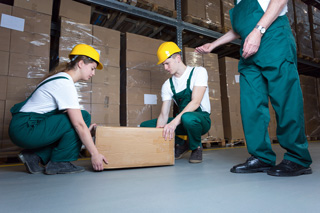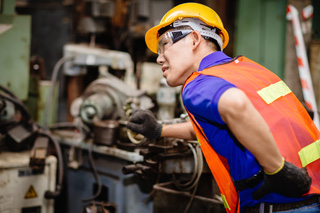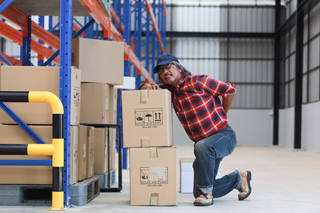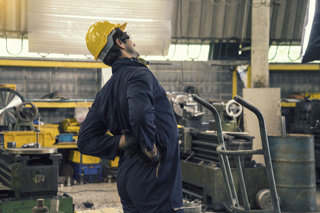- Home
- TrainingABC Blog
- Articles
- Safety
- Back Safety in the Workplace
Back Safety in the Workplace

Author Name: TrainingABC
Posted: 08-07-2021 03:58 AM
Views: 3717
Synopsis: 4 out of 5 people will suffer from significant lower back pain at least once in their lifetime. Statistics show that a great deal of these injuries will occur in the workplace. There are over 1 million workplace back injuries reported every year. Only the common cold accounts for more lost work days.
Workers suffering from acute back pain should seek medical attention.
4 out of 5 people will suffer from significant lower back pain at least once in their lifetime. Statistics show that a great deal of these injuries will occur in the workplace. There are over 1 million workplace back injuries reported every year. Only the common cold accounts for more lost work days.
According to the CDC, more workers’ compensation claims are filed for the back than any other injury. Back injuries cost employers 225 billion annually in claims, lost sick days and productivity. Commercial and Industrial workers are at high risk for back injury. Employers are required to implement Occupational Health and Safety training to protect their employees.
 Why Does My Back Hurt?
Why Does My Back Hurt?
Back pain is caused by an overstretched or torn ligament, tendon or muscle of the back, spinal disc deterioration, or on rare occasions a spinal nerve or bone related injury. The back encompasses the spine, spinal chord, vertebrae, spinal discs for cushion, and over 1400 ligaments, tendons and muscles to stabilize.
With the physical demands of commercial and industrial facilities, back injuries are more frequent.
Common causes of back pain that increase a worker's risk of injury include:
- Improper lifting and carrying techniques
- Poor posture
- Lifting heavy, bulky or awkward loads
- Twisting while lifting or carrying loads
- Reaching overhead
- Bending unsafely to pick up items from the floor
- Years of misuse and neglect
- Lack of exercise
- Lack of flexibility
- Poor sleeping position
- Standing or sitting still for long periods of time
 How to Heal the Back and Prevent Injury
How to Heal the Back and Prevent Injury
Although the sources of back pain are complex, it can be alleviated by making alterations to some of these primary factors:
- Pain relief strategies
- Lifting and carrying techniques
- Proper use of lifting equipment
- Sleep conditions
- Posture
- Ergonomic changes
- Flexibility and exercise regime
- Use of personal protective equipment (PPE)
Correct Lifting and Carrying Techniques
Most back injuries that occur in the workplace happen when items are lifted incorrectly. Through preparation, and by exercising proper lifting, carrying, and placing procedures, the risk of injury is significantly reduced.
- When possible, plan before lifting an object.
- Decide where the load will be placed and choose the shortest, most obstacle-free route.
- Never lift or carry an unbalanced load
- If the item is too bulky or the weight exceeds a comfortable lift, get help or use a mechanical device.
 Whether alone or with a partner, always…
Whether alone or with a partner, always…
- Check loads for tags labeling heavy or unstable
- Eliminate hazards and obstacles that may get in the way
- Prop open any doors on the route
- Check the object’s weight by pushing or lifting an edge
- For unstable or heavy loads tag the load to alert workers
- Squat down to lower the object, without bending at the waist.
- Keep your head up and maintain contact until the load is secure and where you want it.
- Lift the load with legs shoulder width apart and close to the body, bending at the hips and knees, and by using the legs to lift and not the back
- When carrying a one handed load, such as a bucket, mentally glue your free hand on the outside of your thigh to maintain correct back alignment
When lifting or carrying the load…
- Do not lift directly after sitting for a long period
- Favor pushing movements over pulling movements, which can strain the lower back
- Don’t lift objects that block the line of sight without a partner
- Shift your feet to navigate around obstacles instead of twisting the body
- Avoid lifting objects overhead
- Avoid uneven and slippery surfaces
- Reduce larger loads into smaller ones when possible
 When lifting, never bend at the waist. It multiplies the load’s weight and focuses that pressure on the vertebrae in your spine. Carry loads with a straight back without leaning over. When placing a load, set it down standing as close as possible to the destination. Try to use proper techniques for all physical labor at work and at home.
When lifting, never bend at the waist. It multiplies the load’s weight and focuses that pressure on the vertebrae in your spine. Carry loads with a straight back without leaning over. When placing a load, set it down standing as close as possible to the destination. Try to use proper techniques for all physical labor at work and at home.
Lifting Equipment
For tasks not suitable for human movement, use equipment such as a forklift, dolly or cart while wearing appropriate PPE. For specialized equipment like forklifts, employees must be trained and certified before use. Use lift-assist devices like scissor lift tables or load levelers to adjust the load to lift from waist height. Use a ladder or another platform to avoiding lifting loads overhead.
Pain Relief
Behavioral changes and proper treatment that can alleviate stiffness and heal minor injuries effectively include…
- Non-steroidal anti-inflammatories such as aspirin or ibuprofen
- Ice and heat
- Stretching and exercise
- Removing wallets and other objects from back pockets before sitting - Sitting with a wallet in the hip pocket can misalign the spine and may also press on nerves that affect the back and legs. Removal can bring rapid relief.
- Wearing well-cushioned, slip resistant footwear
Gentle exercise may be the most effective way to speed recovery from lower back pain.
- For flexibility and to treat back spasms, bring the knees towards the chest to stretch the lower back muscles.
- Stop stretching if you experience sharp pains.
- Do exercises to strengthen the back.
- Engage in low impact exercises, like walking, swimming and bike riding.
- When nursing a sore back, avoid high impact activities like running that increase back injuries.
- If your back keeps giving you trouble, see your doctor and consult a physician before any exercise program or diet.
 Ergonomics
Ergonomics
There are simple ways to adjust and fit work areas to prevent back injuries.
Before beginning work tasks, take the time to identify work activities that create potential back strain or injury and adjust the worksite for them.
- When possible, alternate tasks to minimize repetitive stress.
- Re-arrange frequently used materials to avoid reaching, bending, or twisting
- Use an adjustable height table so work is at waist
level - Position storage centers close to conveyor belts
and other workstations - Identify hazards, work practices, equipment and
other risk factors and report them to management - Make suggestions to supervisors about reducing hazards
- Adjust chair, table, and shelving height if the work is
too low or too high - Avoid lifting from the floor or lifting higher than your shoulders
- Use a lumbar supporting chair, anti-fatigue floor mats, and footrests, to reduce injuries.
Sleep Conditions
Changing the normal sleep position and altering the bed condition can significantly reduce back pain. The best sleep position is on the back. It evenly distributes weight across the body and reduces pressure points. Side sleepers should alternate sides to decrease pain points and place a pillow between knees to align the spine. Avoid sleeping on the stomach as it puts pressure on the spine and places the neck in an unnatural position. When sleeping on a softer mattress, place plywood between the mattress and box spring for better back support.
Posture
Injuries can occur from sitting or standing for long periods of time in an awkward posture. Awkward posture such as slouching or twisting at the waist puts pressure on back ligaments instead of muscles. The ligaments stretch and hurt while putting pressure on vertebrae. A neutral posture is achieved when muscles and joints are resting and relaxed, placing minimal stress on body parts.
To keep a neutral position and reduce pain while standing:
- Keep spine aligned and shoulders back
- Alternate propping one foot on a stool to reduce lower back stress
- If standing for long periods, shift weight from one leg to the other
- Stretch frequently
- Avoid slouching
To maintain correct neutral sitting posture and reduce pain…
- Refrain from protruding the head in front of the body
- Keep shoulders back and relaxed, not hunched
- Keep forearms and thighs parallel to the floor
- Adjust the back of your chair for support
- Place feet on a block or footrest (if needed) to maintain a 90 degree angle keeping pressure off the back
- Place a pillow behind the back for lumbar support
- Sit back in your chair not on the front edge
Maintaining the same static position, even in a neutral posture for an extended period of time can cause additional muscle fatigue so move and stretch often.
Consequences
Almost 20 percent of all workers’ compensation claims are attributed to back pain with over half a million employees filing claims every year. Back injuries create higher medical costs, legal expenses, lost productivity and increased absenteeism. Workers with back injuries are absent from work four days more per year than those without back injuries. One out of every five workers absent from work with back pain are unable to return to work within a month, creating additional costs to train replacements.
Conclusion
Back injury prevention reduces error and incident rates, turnover, workers’ compensation claims, operating costs and medical expenses. Taking the steps to ensure employees lift the proper way and use the right equipment, reduces their pain and protects them from job-related hazards. Reducing back pain and injury not only increases productivity and elevates morale but it improves the very quality of employees’ lives.
Check TrainingABC's new back safety training course.
